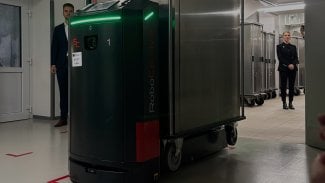mkrescue
NAME
mkrescue - make rescue floppy
SYNOPSIS
/usr/sbin/mkrescue
- make a bootable rescue floppy or CD using the default kernel specified
in lilo.conf.
DESCRIPTION
mkrescue
takes its specification for the kernel from the default image specified in
/etc/lilo.conf. If the actual default is an other= specification,
then use the first image= specification.
Any associated initial ramdisk (initrd=), and append=
options will also be used. The root directory will be taken to be the
current root. A bootable floppy or CD-image will be created using LILO version
22.5.5 or later.
mkrescue
normally requires no options, unless a CD-image is desired (--iso).
OPTIONS
I --append <string>
Override any append= options taken from the default image. If there is
any doubt about whether the lilo.conf options are correct, then specify
no kernel parameters with: --append "", the null string.
I --debug
Provide verbose output of the operation of "mkrescue", pausing to allow
the setting of internal operating parameters to be viewed. "<CR>" must
be hit to proceed from these pauses.
I --device <device>
Make the floppy on a device other than /dev/fd0. The floppy disk will
always be made to boot on BIOS device code 0x00 (A: drive), without
regard to the drive on which it is created.
I --fast
Use a faster method of creating the boot floppy. This involves first
creating a file of "--size" 1k blocks (default is 1440)
mounted using a loopback device, creating the bootable floppy,
then copying the entire file to the disk.
I --fs [ ext2 | msdos | minix ]
Specify the type of filesystem to create on the drive.
ext2
is the default, but "msdos" and "minix" allow slightly more disk sectors
for really big kernels.
I --help
Print a short usage synopsis, including a list of command options.
I --image <label>
Specifies the label or alias of the particular image from which the
append, initial ramdisk, root, keytable, and kernel information is to be
taken.
I --initrd <filepath> and --kernel <filepath>
These options, which must be used together, allow specification of an
arbitrary kernel file and initial ramdisk file to be used on the created
boot floppy. Be sure you know what you are doing before you use these
options. If no initial ramdisk is needed with a particular kernel, then you
MUST specify --initrd "", meaning a null pathname.
I --install [ text | menu ]
Allows overriding the default human interface used with the rescue
bootloader (configuration file "install=" option). "text" is the
default on 1.2MB and 1.44MB floppy disks, and "menu" is the default on
2.88MB floppies and HD emulation on CD-R media.
I --iso
Create an ISO-9660 bootable CD image (El Torito Format) suitable for burning
to a CD-R or CD-RW. The --device specification defaults to the
filename "rescue.iso", and the --size defaults to 2880. A utility
such as cdrecord may be used to burn the ISO file to a recordable CD
medium. With this ISO option, the
--size HD
option is allowed.
I --nocompact
For faster kernel loading from a floppy, LILO map compaction is normally
enabled. This option will disable map compaction by omitting the
lilo "-c" switch.
I --noformat
Suppresses creation of a new filesystem on the boot floppy. This option may
be used
only
when you know that the floppy you will be writing upon is formatted with the
same filesystem as specified by "--fs XXX" (default is ext2).
I --root <device>
Specify the root filesystem for the kernel on the boot floppy. The currently
mounted root is taken as the default specification.
I --size [ 1440 | 1200 | 2880 | HD ]
The default floppy disk size is 1440, meaning a 1.44MB floppy. When --iso
is specified, the default size is 2880. Allowed
specifications are 1200, 1440, or 2880, meaning a 1.2MB, 1.44MB or 2.88MB
floppy, respectively. No other floppy disk sizes are supported.
The
HD
specification, meaning "hard disk", may only be used with the
--iso
option, to indicate a 16MB hard disk is to be generated for emulation. This
allows for very large kernel / initial ramdisk combinations on CD-R. The
hard disk image is created using loopback devices
"/dev/loop0" and "/dev/loop1", which
must be free to utilize this size option.
I --version
Print the version number of mkrescue, then terminate.
SEE ALSO
lilo(8), lilo.conf(5), mkfs(8), dd(1), mount(8), mkinitrd(8), mkisofs(8),
cdrecord(1).
AUTHOR
John Coffman <johninsd@san.rr.com> (3.0)



















